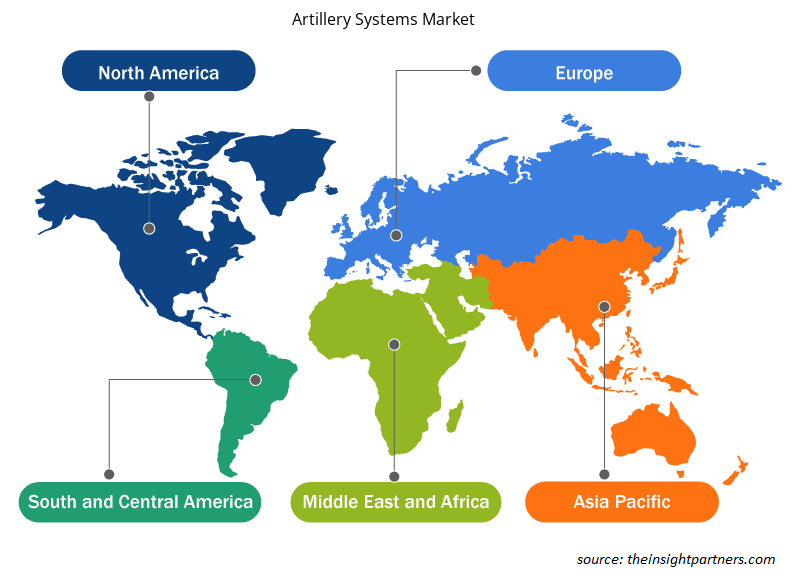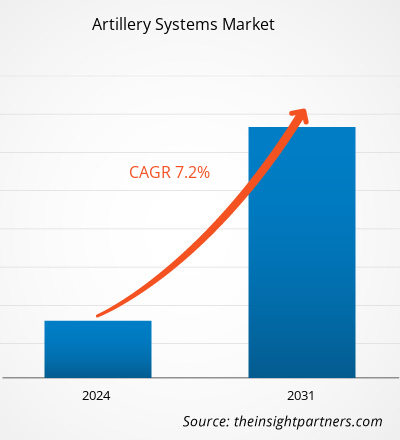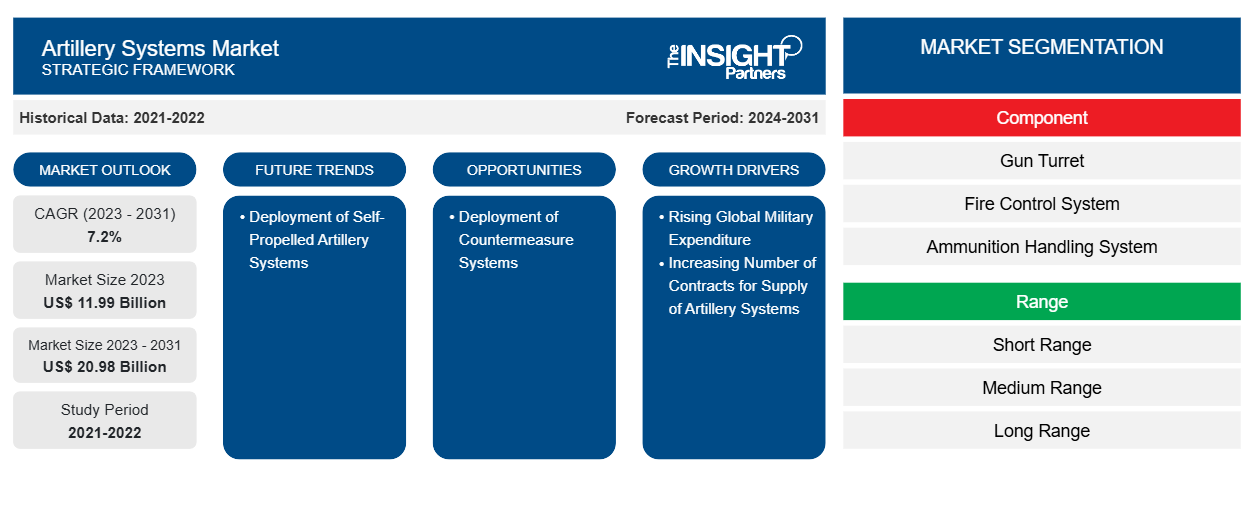Se proyecta que el tamaño del mercado de sistemas de artillería alcance los 20.980 millones de dólares en 2031, frente a los 11.990 millones de dólares en 2023. Se espera que el mercado registre una CAGR del 7,2 % durante el período 2023-2031. Es probable que el creciente despliegue de sistemas de artillería autopropulsados traiga nuevas tendencias al mercado.
Análisis del mercado de sistemas de artillería
El aumento de los gastos militares en los países y el aumento de las tensiones entre ellos son algunos de los principales factores que impulsan la demanda de sistemas de artillería en todo el mundo. Varios países están tomando medidas serias para garantizar la seguridad de su nación, por lo que están colaborando con otros países uniendo fuerzas para aumentar las capacidades de sus fuerzas armadas. Por ejemplo, tras el conflicto entre Rusia y Ucrania, Estados Unidos ha estado tomando iniciativas para aumentar su presencia militar en los países europeos a largo plazo estableciendo su primera presencia permanente en Polonia para reforzar la seguridad regional. Se están desplegando varias fuerzas en el país, junto con la munición y las armas de fuego necesarias. Estas iniciativas están impulsando el crecimiento del mercado de sistemas de artillería en todo el mundo.
Panorama del mercado de sistemas de artillería
Los sistemas de artillería permiten a las fuerzas armadas neutralizar o destruir objetivos durante cualquier combate o operación de fuego. Algunos de los principales factores que impulsan el crecimiento de los sistemas de artillería incluyen el aumento del gasto militar mundial, el aumento del número de contratos para el suministro de sistemas de artillería y el creciente despliegue de sistemas de artillería autopropulsada por parte de diversas fuerzas armadas en todo el mundo.
Es probable que la introducción de armas y municiones inteligentes, incluidos misiles guiados de precisión, morteros guiados y sistemas de artillería guiada, impulse el crecimiento del mercado de sistemas de artillería durante el período de pronóstico. Además, la adquisición de aeronaves militares, helicópteros de combate, sistemas de artillería, vehículos de mortero, vehículos de combate de infantería y tanques en grandes cantidades respalda el crecimiento de la industria de armas de fuego y municiones en todo el mundo.
Personalice este informe según sus necesidades
Obtendrá personalización en cualquier informe, sin cargo, incluidas partes de este informe o análisis a nivel de país, paquete de datos de Excel, así como también grandes ofertas y descuentos para empresas emergentes y universidades.
- Obtenga las principales tendencias clave del mercado de este informe.Esta muestra GRATUITA incluirá análisis de datos, desde tendencias del mercado hasta estimaciones y pronósticos.
Factores impulsores y oportunidades del mercado de sistemas de artillería
Aumento del gasto militar mundial
El cambiante escenario de la guerra moderna ha obligado a los gobiernos de varios países de todo el mundo a asignar fondos significativos y ayuda financiera a las respectivas fuerzas militares y de defensa. La asignación del presupuesto de defensa apoya al ejército y a las fuerzas militares para obtener tecnologías y equipos mejorados de desarrolladores nacionales o internacionales. Por otro lado, las actualizaciones de vehículos militares y del ejército están en aumento debido a la creciente asignación del presupuesto de defensa. Además, el aumento del gasto gubernamental muestra el enfoque de los gobiernos en el fortalecimiento de las fuerzas de seguridad nacional. Existe una mayor necesidad de reforzar las fuerzas militares y de seguridad fronteriza con equipos avanzados de vigilancia , comunicación, navegación, artillería, armamento y vehículos, entre otros; por lo tanto, las fuerzas militares de todo el mundo se están centrando en invertir cantidades significativas en la adquisición de sistemas de artillería y otras tecnologías avanzadas. La inclinación constante de las fuerzas de defensa a adquirir nuevas tecnologías para operaciones de combate y no combate impulsa aún más el gasto militar en todo el mundo.artilleries, armaments, and vehicles, among others; thus, military forces worldwide are focusing on investing significant amounts in procuring artillery systems and other advanced technologies. Defense forces' constant inclination to acquire new technologies for noncombat and combat operations further boosts military expenditure worldwide.
Según el Instituto Internacional de Investigación para la Paz de Estocolmo (SIPRI), el gasto militar mundial aumentó a 2443 mil millones de dólares en 2023, lo que representa un aumento del 13,7% con respecto a 2022. Estados Unidos, China, India, Rusia y Arabia Saudita fueron los cinco países que más gastaron en 2023, representando alrededor del 61% del gasto mundial. La siguiente figura muestra el gasto anual de estos países.
Gasto militar de los cinco principales países (2021-2023)
País | 2021 (miles de millones de dólares estadounidenses) | 2022 (miles de millones de dólares estadounidenses) | 2023 (miles de millones de dólares estadounidenses) |
A NOSOTROS | 800.67 | 876,94 | 916.00 |
Porcelana | 293.35 | 291,96 | 296,00 |
Rusia | 65,91 | 86.37 | 109.01 |
India | 76,59 | 81.36 | 83,60 |
Arabia Saudita | 55,56 | 75.01 | 75,80 |
Fuente: SIPRI
El aumento del gasto militar favorece la incorporación de tecnologías avanzadas de guerra, como antenas de largo alcance, artillería autopropulsada, dispositivos de comunicación avanzados, vehículos no tripulados, radares, sistemas de detección de misiles, sistemas de vigilancia y navegación y tecnologías de guerra modernas. Además, un elevado presupuesto militar permite a los países asignar recursos para el avance y la modernización de sus sistemas de defensa aéreos, terrestres y navales existentes.
Despliegue de sistemas de contramedidas
El cambiante escenario geopolítico mundial aumenta la necesidad de contar con sistemas de contramedidas de defensa fuertes. La tensión constante entre naciones como Rusia-Ucrania, India-China, Pakistán-India, Israel-Palestina y Estados Unidos-China está obligando a sus gobiernos a fortalecer sus respectivas fuerzas armadas, lo que también está impulsando la adquisición de sistemas de guerra como diferentes tipos de morteros y obuses. Por lo tanto, las fuerzas armadas de diferentes países están invirtiendo en la adquisición de sistemas de artillería como artillería de cohetes tierra-aire, obuses autopropulsados, sistemas de alerta temprana y sistemas de vigilancia fronteriza. BAE Systems, General Dynamics Corporation, Honeywell International Inc., Israel Aerospace Industries Inc., Leonardo SpA, Lockheed Martin Corporation, Northrop Grumman Corporation, Raytheon Technologies Corporation, SAAB AB y Thales Group se encuentran entre las empresas que se centran en el desarrollo de sistemas de contramedidas de defensa, incluidos sistemas de radar, sistemas de artillería, sistemas de comunicación y vigilancia y dispositivos de navegación. Por lo tanto, se espera que la creciente adquisición y despliegue de sistemas de contramedidas impulse el crecimiento del mercado de sistemas de artillería en los próximos años.
Análisis de segmentación del informe de mercado de sistemas de artillería
Los segmentos clave que contribuyeron a la derivación del análisis del mercado de sistemas de artillería son el calibre, el alcance, el tipo y el componente.
- Según los componentes, el mercado mundial de sistemas de artillería se segmenta en torretas, sistemas de control de fuego, sistemas de manipulación de municiones, sistemas auxiliares y otros. El segmento de sistemas de control de fuego tuvo la mayor participación de mercado en 2023.
- Según el alcance, el mercado se divide en corto alcance, mediano alcance y largo alcance. El segmento de corto alcance tuvo la mayor participación del mercado en 2023.
- Por tipo, el mercado se divide en obuses, morteros y artillería de cohetes. El segmento de obuses tuvo la mayor participación del mercado en 2023.
- En términos de calibre, el mercado se divide en calibre pequeño, calibre medio y calibre grande. El segmento de calibre medio tuvo la mayor participación del mercado en 2023.
Análisis de la cuota de mercado de los sistemas de artillería por geografía
El alcance geográfico del informe del mercado de sistemas de artillería se divide principalmente en cinco regiones: América del Norte, Asia Pacífico, Europa, Medio Oriente y África, y América del Sur y Central.
El mercado mundial de sistemas de artillería está segmentado en América del Norte, Europa, Asia Pacífico, Oriente Medio y África, y América del Sur. América del Norte tuvo la mayor participación en el mercado de sistemas de artillería en 2023 y se prevé que mantenga su dominio durante el período de pronóstico. El mercado mundial de sistemas de artillería desempeña un papel fundamental en la configuración de las capacidades militares de las naciones, influyendo en las estrategias de defensa y contribuyendo a la dinámica geopolítica. Con un panorama multifacético influenciado por los avances tecnológicos, las amenazas a la seguridad y las colaboraciones internacionales, el mercado de sistemas de artillería se caracteriza por los esfuerzos de modernización en curso, la diversificación de capacidades y la integración de tecnologías de vanguardia. La demanda de capacidades de artillería diversificadas es un factor clave que configura el mercado global. Las naciones buscan sistemas de artillería que puedan abordar un espectro de escenarios operativos, desde la guerra convencional hasta las operaciones de contrainsurgencia. Esta diversificación incluye el desarrollo y la adquisición de varios tipos de artillería, como obuses remolcados, artillería autopropulsada, lanzacohetes y morteros. El objetivo es poseer un portafolio de artillería versátil que pueda responder eficazmente a diferentes amenazas y terrenos.
Perspectivas regionales del mercado de sistemas de artillería
Los analistas de Insight Partners explicaron en detalle las tendencias y los factores regionales que influyen en el mercado de sistemas de artillería durante el período de pronóstico. Esta sección también analiza los segmentos y la geografía del mercado de sistemas de artillería en América del Norte, Europa, Asia Pacífico, Oriente Medio y África, y América del Sur y Central.

- Obtenga datos regionales específicos para el mercado de sistemas de artillería
Alcance del informe de mercado de sistemas de artillería
| Atributo del informe | Detalles |
|---|---|
| Tamaño del mercado en 2023 | US$ 11,99 mil millones |
| Tamaño del mercado en 2031 | US$ 20,98 mil millones |
| CAGR global (2023 - 2031) | 7,2% |
| Datos históricos | 2021-2022 |
| Período de pronóstico | 2024-2031 |
| Segmentos cubiertos | Por componente
|
| Regiones y países cubiertos | América del norte
|
| Líderes del mercado y perfiles de empresas clave |
|
Densidad de actores del mercado: comprensión de su impacto en la dinámica empresarial
El mercado de sistemas de artillería está creciendo rápidamente, impulsado por la creciente demanda de los usuarios finales debido a factores como la evolución de las preferencias de los consumidores, los avances tecnológicos y una mayor conciencia de los beneficios del producto. A medida que aumenta la demanda, las empresas amplían sus ofertas, innovan para satisfacer las necesidades de los consumidores y aprovechan las tendencias emergentes, lo que impulsa aún más el crecimiento del mercado.
La densidad de actores del mercado se refiere a la distribución de las empresas o firmas que operan dentro de un mercado o industria en particular. Indica cuántos competidores (actores del mercado) están presentes en un espacio de mercado determinado en relación con su tamaño o valor total de mercado.
Las principales empresas que operan en el mercado de sistemas de artillería son:
- Avibras Industria Aeroespacial S/A
- BAE Systems Plc
- Grupo Nexter KNDS
- Sistemas terrestres de Denel
- Elbit Systems Ltd
- Dinámica general
Descargo de responsabilidad : Las empresas enumeradas anteriormente no están clasificadas en ningún orden particular.

- Obtenga una descripción general de los principales actores clave del mercado de sistemas de artillería
Noticias y desarrollos recientes del mercado de sistemas de artillería
El mercado de sistemas de artillería se evalúa mediante la recopilación de datos cualitativos y cuantitativos a partir de investigaciones primarias y secundarias, que incluyen importantes publicaciones corporativas, datos de asociaciones y bases de datos. A continuación, se enumeran algunos de los avances en el mercado de sistemas de artillería:
BAE Systems ha firmado un contrato por valor de 466 millones de dólares para suministrar al ejército estadounidense sus obuses autopropulsados M109A7 Paladin. Según el anuncio del Departamento de Defensa de Estados Unidos, el contrato incluye el suministro de vehículos de apoyo para artillería de campaña M992. No se ha revelado la cantidad específica de obuses y vehículos de apoyo incluidos en el pedido. (Fuente: BAE Systems, comunicado de prensa, febrero de 2023)
Informe sobre el mercado de sistemas de artillería: cobertura y resultados
El informe "Tamaño y pronóstico del mercado de sistemas de artillería (2021-2031)" proporciona un análisis detallado del mercado que cubre las siguientes áreas:
- Tamaño del mercado de sistemas de artillería y pronóstico a nivel mundial, regional y nacional para todos los segmentos clave del mercado cubiertos bajo el alcance
- Tendencias del mercado de sistemas de artillería, así como dinámicas del mercado, como impulsores, restricciones y oportunidades clave
- Análisis PEST y FODA detallados
- Análisis del mercado de sistemas de artillería que abarca las tendencias clave del mercado, el marco global y regional, los principales actores, las regulaciones y los desarrollos recientes del mercado
- Análisis del panorama de la industria y de la competencia que abarca la concentración del mercado, el análisis de mapas de calor, los actores destacados y los desarrollos recientes del mercado de sistemas de artillería
- Perfiles detallados de empresas
- Análisis histórico (2 años), año base, pronóstico (7 años) con CAGR
- Análisis PEST y FODA
- Tamaño del mercado, valor/volumen: global, regional y nacional
- Industria y panorama competitivo
- Conjunto de datos de Excel
Informes recientes
Testimonios
Razón para comprar
- Toma de decisiones informada
- Comprensión de la dinámica del mercado
- Análisis competitivo
- Información sobre clientes
- Pronósticos del mercado
- Mitigación de riesgos
- Planificación estratégica
- Justificación de la inversión
- Identificación de mercados emergentes
- Mejora de las estrategias de marketing
- Impulso de la eficiencia operativa
- Alineación con las tendencias regulatorias























 Obtenga una muestra gratuita para - Mercado de sistemas de artillería
Obtenga una muestra gratuita para - Mercado de sistemas de artillería